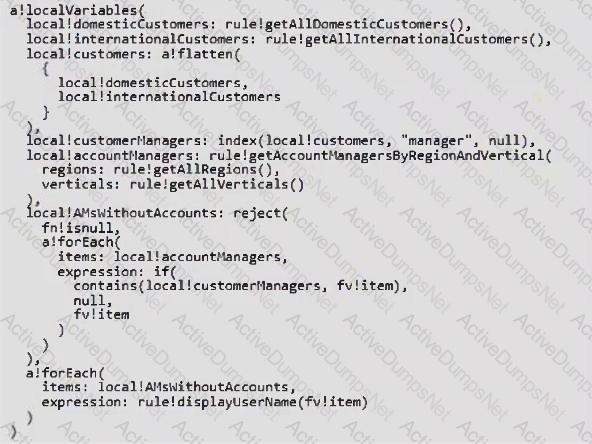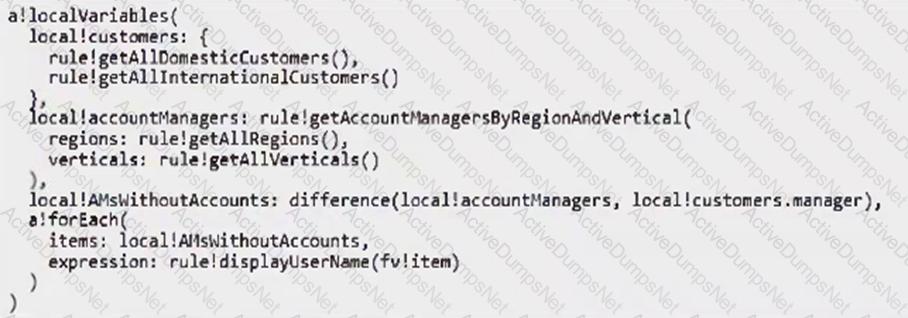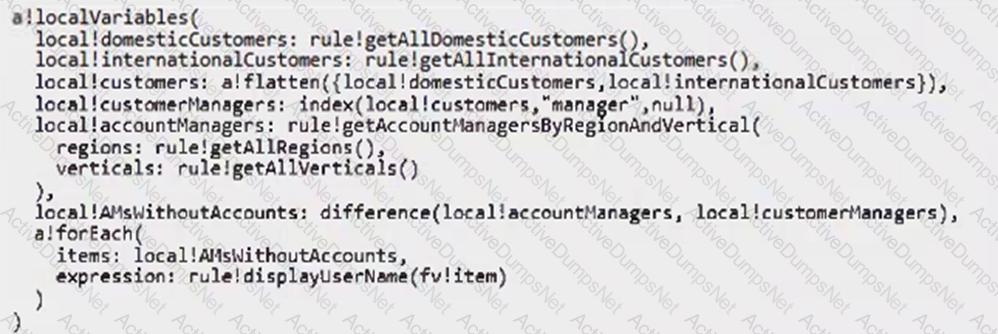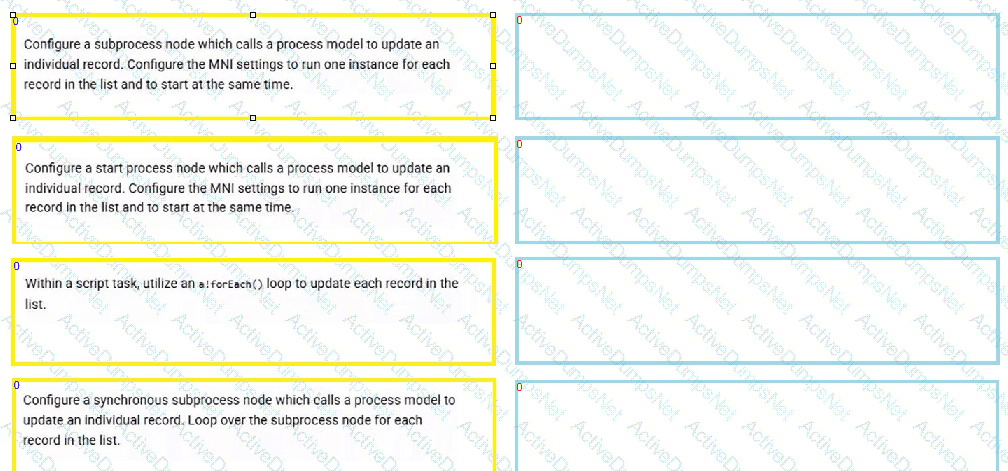Appian ACD201 Appian Senior Developer Exam Practice Test
Appian Senior Developer Questions and Answers
An energy company wants to allow the public to be able to report power outages directly and provide supporting documentation in the form of photos and/or videos. The company also requires the reporter's contact details.
How can a developer design and implement this requirement in Appian?
You need to implement a field-level audit functionality on the application data, and then display a log of the changes made over time to the users.
What should you do?
Which section of the Interface Performance View explains the contribution towards the overall evaluation time of the current function, rule, or parameter?
You need to create a read-only grid that displays support case information. Data for the support cases is mapped to the "Case" record type with data sync enabled.
Within the record, there are fields named "createdDateTime" and "resolvedDateTime". These two fields store the timestamps for when a case is created and resolved, respectively.
The grid includes a column indicating the number of hours between when the case was created and when it was resolved. This column must be sortable within the grid.
How should you calculate the hour value that will display in the column?
You need to configure your process model to store the result of an expression rule for every item in a list. Your design must have the smallest memory footprint.
What should you do?
After reviewing the latest Expression performance logs, you notice you have several expressions contributing to slow interface or process performance.
Which two conditions will lead to a higher risk associated with slow-performing expressions? (Choose two.)
You need to write an expression to retrieve a list of all account managers who don't currently have an active customer account.
Which code snippet should you use?
A)

B)

C)

You're creating a new record type with data sync enabled. Users in the "ACME Employees" group must be able to access the record list and start the New Case action.
What are two valid steps that you should perform to grant users the appropriate access? (Choose two.)
You need to test a related action that updates record data.
Appropriate users must be able to access the form. You also need to ensure that the data is successfully updated.
Using Appian, which is the best testing method you should use?
You're reviewing the data store performance logs. You notice several items were logged in the generated slow query log file: perf_monitor_rdbms_slow.csv.
What is the default threshold value for a slow query to be included in this log file?
Your client reported that a form in the application is very slow to load.
You investigate and find a query entity which is nor performing well.
Which action should you perform to improve query performance for the query entity?
You're creating a process to update specific fields in a list of records and you save the updated records to the database.
You're given the following performance considerations:
 Execution time
Execution time
 Process instance memory usage
Process instance memory usage
 Process execution engine load balancing
Process execution engine load balancing
Based on these performance metrics, rank the options from best to worst.
Note: To answer, move all steps from the Options list to the Answer List area and arrange them in the correct ranking order (best at the top, and worst at the bottom).

You need to configure the security for the synced record type Case.
Your requirements are:
Only users in the "Archive Management" group can access cases in the "Archived" status.
Cases in the status "Deleted" are accessible to no one.
Users in the "All Users" group can already access the record.
What should you do?
A process was recently pushed to the Prod environment. However, users are reporting that a task on this process is experiencing slow response times when they try to input data.
What is the most likely reason for this issue?
Which two items are configured in the Admin Console when you create a web API? (Choose two.)
You're inspecting the items in a deployment package for issues you might have missed during package preparation.
Which two objects can be in your list of missing precedents for an application? (Choose two.)
You’re establishing a Health Check schedule for your department.
Which two statements should you consider when implementing Health Checks? (Choose two.)
What should you use to create a predefined query in a database for ease of use?
You're conducting a code review and notice that some accessibility features are missing on the interfaces.
Which two UX best practices should be followed to align with accessibility requirements? (Choose two.)
In reviewing the process model metrics of your application, you notice a process model with a completion rate of only 10%.
What are two possible reasons for this low completion rate? (Choose two.)
A recent Health Check report of your application indicates an increased risk of large context size in the interfaces.
What are two possible contributors to this risk? (Choose two.)
You’re making a POST request to the Appian web API. You need to include complex data structures, such as lists or objects, in the request body.
How should you design the API to accept those requests?
You’re designing a file upload process that integrates with an external document management system.
Part of this process is to develop a start form with a file upload component, so that the user can upload multiple files.
The business has requested that the maximum file size that can be uploaded through this process is 1GB. Additionally, you’re aware that the integration's API can accept files with a maximum file size of 3GB, but recommends no larger than 1GB.
Can the process be more performant without straining the application or integration?
You're refining a story regarding a highly regulated form, where information needs to be sent to a regulatory body at the end of each month to ensure that the business complies with laws and legislation. The story only concerns the creation of the form.
You need to create a form that captures information to comply with the regulatory requirements.
Which two questions should you ask the business? (Choose two.)
You're creating a process model that will serve as the case creation workflow.
Your requirements:
This process captures input from the user before executing a series of unattended subprocess nodes.
Each subprocess performs extended data processing which is dependent on output from each of the previous nodes.
An activity chained task node is displayed asking the user if they'd like to create another case.
What should you do?
You're conducting a design review.
You identify slow-performing expression rules querying a specific data store, and need to understand the "number of operations against data stores."
Which metric from the data_store_details.csv file is helpful to you?
You're performing System Integration Testing on a client's application that integrates with an external system.
In this instance, you're testing the application's interactions with external integrations to ensure that data is being handled correctly between the two systems. However, this step has been done manually and is time-consuming.
What should you do to make this process more efficient?
You run a report on different employee transactions by using a View.
You encounter the following error: "a!queryEntity: An error occurred while retrieving the data."
What is the most likely root cause of this error?
You're developing a record view for a case management system that enables users to upload files to a specific location within an external records application.
Your requirements are:
In this record view, there should be a record action that allows the user to upload a file to the interface and configure the metadata (name, author, file size) before submitting.
If the file is larger than 250MB, the user will be notified that the file will be uploaded overnight.
Once the file has been successfully uploaded, the file will appear on the record view and the user can interact with the file.
Which two pieces of user-facing information must be captured from this business process so that you can develop this record view? (Choose two.)


 C:\Users\Waqas Shahid\Desktop\Mudassir\June - July 2025\Untitled.jpg
C:\Users\Waqas Shahid\Desktop\Mudassir\June - July 2025\Untitled.jpg